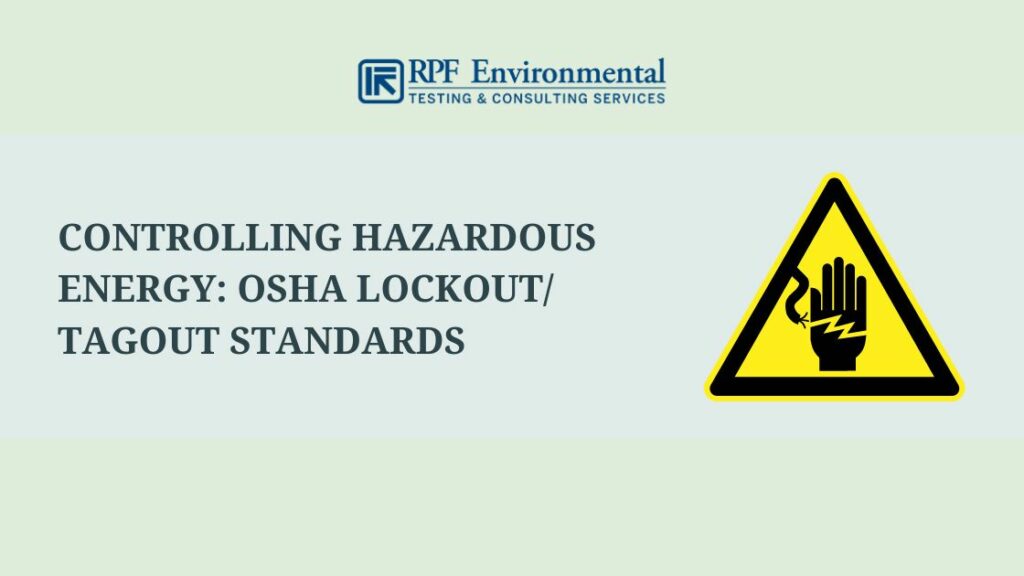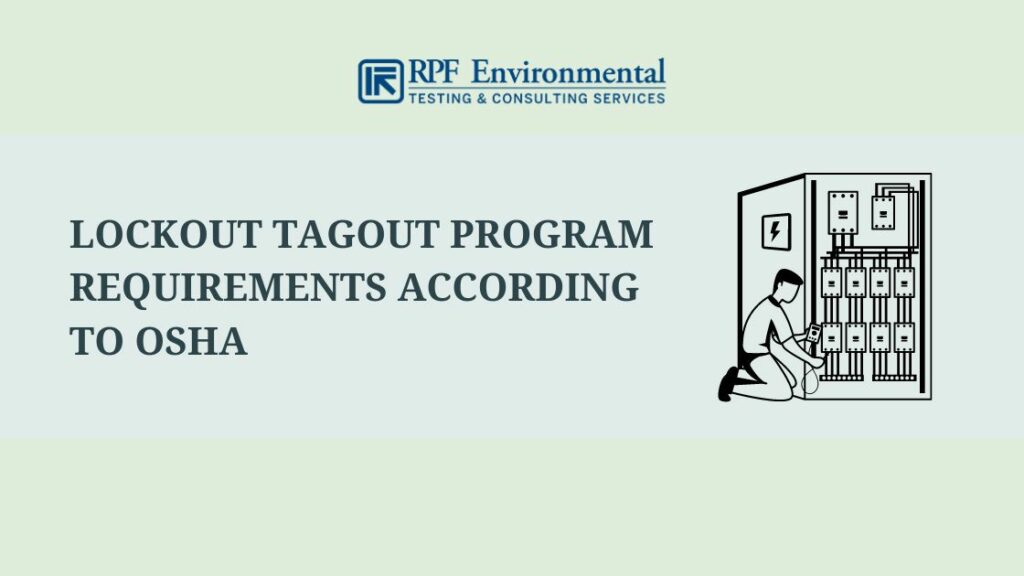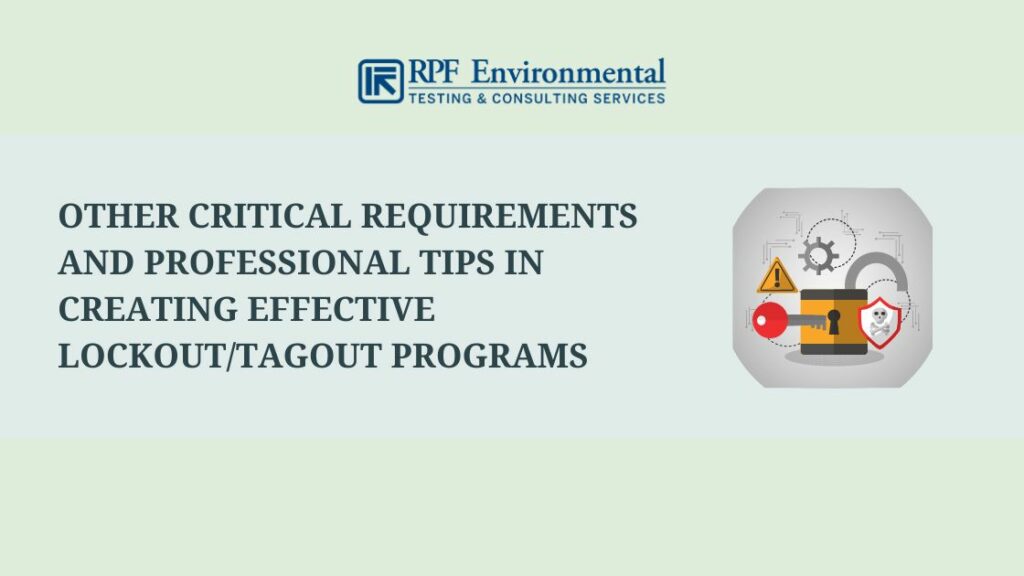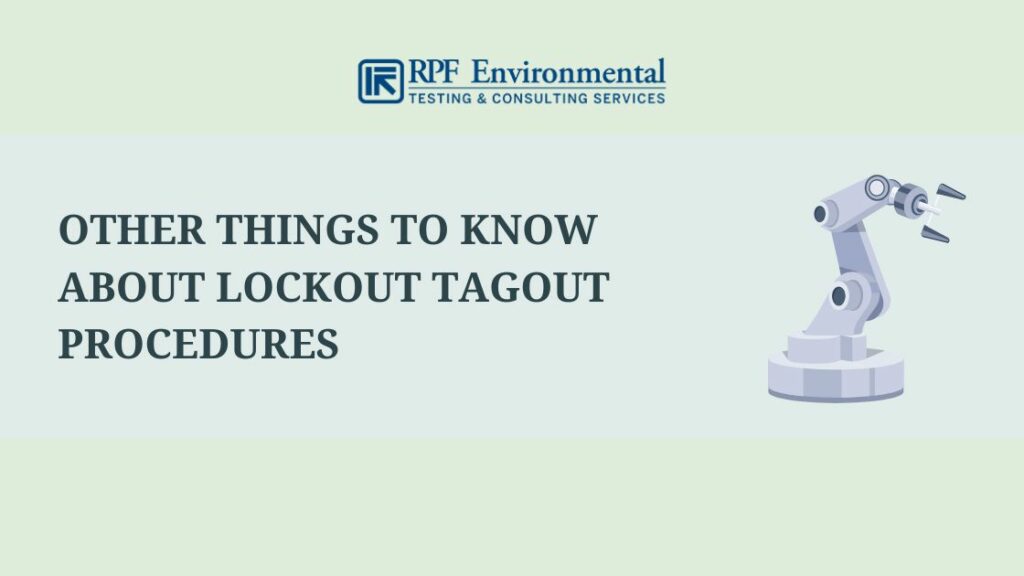OSHA’s lockout/tagout standard requires employers to establish an energy control program to comply with the standards. The program aims to guarantee the safety of the workers by properly isolating the energy source before any maintenance or servicing tasks are performed.
Part of this program is the development and utilization of energy control procedures which we will be discussing in detail here as per OSHA’s standards. Thus, helping you develop effective LOTO programs to ensure compliance and prevent costly violations and accidents in the workplace.

Maximize safety in your workplace through RPF Environmental’s professional environmental health and safety training programs that include lockout/tagout training. We serve clients in Massachusetts, Maine, New Hampshire, and other areas across the country. Contact us now!
Definition of Terms: Understanding Lockout Tagout Procedures
To help you fully understand LOTO procedures, below are the common terms we will be using all throughout this article:
What is Lockout Tagout?
Lockout/tagout is a set of practices and procedures that ensure the proper isolation of equipment from potential sources of hazardous energy. These sources can be electrical, mechanical, chemical, thermal, pneumatic, hydraulic, or others. Thus, making sure that the equipment won’t accidentally start up (“energized”) again while repairs, maintenance, or servicing activities are ongoing.
Learn more about the difference between lockout and tagout in this blog.
What Are Energy Isolating Devices?
According to OSHA, energy isolating devices are mechanical devices that physically prevent the release or transmission of energy like switches, valves, and breakers.
What Are LOTO Devices?
Lockout devices often come in the form of locks and hold the energy-isolating device in an OFF or SAFE position. They physically prevent the equipment from unauthorized startup unless they are removed using a key.
On the other hand, tagout devices are warning devices (e.g. tags) fastened to energy-isolating devices to warn others that maintenance is ongoing. Tagout devices should always be used with lockout devices. This is unless lockout is impossible to which the employer should ensure that he can provide full employee protection.
Authorized Employee
Employees who lock out the equipment for maintenance/servicing purposes.
Affected Employee
Employees who operate the equipment or those working in the area where the equipment under lockout is being serviced/maintained. They can become authorized employees if their duties include doing maintenance or servicing on hazardous equipment.
What Are Lockout Tagout Procedures?
These are written procedures followed by authorized employees for the safe control of potentially hazardous energy during any servicing or maintenance of equipment where the release of energy or unexpected energization can occur.
Controlling Hazardous Energy: OSHA Lockout/Tagout Standards

OSHA has set standards for LOTO, entitled The Control of Hazardous Energy (Lockout/Tagout), which include:
- Employer responsibilities for protecting their workers
- Measures for controlling and addressing hazardous energy during maintenance procedures
[1910.147(a)(1)(ii)] LOTO Standard Scope: What are the exceptions of lockout/tagout requirements?
The standard applies to any maintenance or servicing activities that can release stored energy or unexpectedly start up machines where employees can get injured. However, it doesn’t cover the following:
- Construction & agriculture employment
- Gas and oil well drilling or servicing
- Electrical hazard exposure in electric-utilization installations
- Installations involving electric utilities
Exempted Equipment from Energy Control (LOTO) Procedures
The equipment is exempted if it meets all of these conditions:
- It has no residual or stored energy
- Stored energy won’t reaccumulate after shutdown
- It has only one energy source that you can readily identify or isolate
- Locking out and isolating the energy source will deactivate and completely de-energize the equipment
- The equipment is locked out from that energy source
- Only one lockout device will lock the equipment
- The authorized employee has exclusive control of the lockout device
- It doesn’t create hazards that will affect other employees
- No accidents are involved with the equipment regarding the unexpected release of hazardous energy
Involved Personnel in a Lockout Tagout
The application of LOTO devices should be done by authorized and trained employees. Also, only the employee who installed the device should remove it.
Lockout Tagout Program Requirements According to OSHA

To ensure that you develop an effective LOTO procedure, you should establish a LOTO program consisting of the following:
1. [1910.147(c)(4)] Energy Control Procedures
The employer should develop, document, and utilize procedures for controlling potentially hazardous energy. The procedure should clearly outline the following:
- Scope
- Purpose
- Authorization
- Rules
- Techniques for controlling hazardous energy
- Methods to enforce compliance
Among other specific things that written lockout/tagout procedures should also contain include the following:
- Definition of terms
- Responsibilities of employers and specific types of employees including supervisors before, during, and after a lockout/tagout procedure
- Criteria for lockout and tagout devices to ensure their effectiveness
- Specific steps for the sequence of the procedure from preparation, shutdown, isolation, and lockout/tagout device installation to the removal of LOTO devices and restoration of the equipment to normal operations
- Isolation procedures for specific types of machines or equipment
- Special LOTO situations like testing equipment that is on a lockout/tagout
- Testing requirements to verify the effectiveness of LOTO devices and energy control procedures
- Alternative methods when lockout or tagout can’t be used (these methods should be based on a risk assessment of the equipment)
- Conditions for outside contractors performing maintenance or servicing
- Inspection requirements for written energy-control requirements
- Shift or personnel changes
- Group lockout/tagout procedures
- Employee training and retraining requirements
- Recordkeeping (maintaining inspection and training records)
Step-By-Step Guide: Example of a Lockout Tagout Procedure
The steps for LOTO procedures can vary depending on the needs of the workplace and the equipment. But, below are the basic lockout/tagout steps:
Step 1. Preparation
- Investigating and identifying all sources of hazardous energy and energy-isolating devices to ensure that all devices/hazardous energy that need to be controlled will be locked or tagged out
- Reviewing the written LOTO procedure specific to the equipment/machine to be locked/tagged out and making necessary changes
- Notifying all affected employees and communicating details about the LOTO procedure
Step 2. Shutdown
- Shutting down the equipment using normal stopping procedures such as pushing the stop button
- Ensuring that all controls are turned off and that moving parts (e.g. gears) completely stopped moving
Step 3. Isolation
- Isolating the equipment from all energy sources by using isolating devices like valves, switches, or circuit breakers
- Dissipating or restraining stored energy (e.g. hydraulic systems, rotating flywheels, etc.) through blocking, repositioning, etc.
Step 4. Lockout/Tagout Device Installation
- Locking/tagging out all energy-isolating devices using their assigned LOTO devices
Step 5. Isolation Verification
- Verifying that no other workers are exposed
- Double-checking the equipment to ensure that it is disconnected from all energy sources
- Testing all buttons and normal operating controls to ensure that they’re not working
- Ensuring that you return all buttons/operating controls to their OFF position after verifying isolation
Step 6. Equipment Restoration
After completing maintenance or servicing tasks, the following steps will follow:
- Ensuring that the equipment is reassembled completely including safety devices and machine guards
- Removing and clearing tools from the equipment and work area
- Verifying that no personnel is exposed
- Removing lockout and tagout devices
- Re-energizing the equipment
- Informing affected employees about the completion of the maintenance/servicing
2. [1910.147(c)(6)] Periodic LOTO Inspection
Energy control procedures should be inspected at least once a year to make sure that they are being followed including OSHA standards. Inspections also aim to correct inadequacies if any have been identified.
The documentation for annual inspections will include:
- The inspector
- Inspection date
- Employees involved in the inspection
- The equipment
LOTO inspections also include reviewing the responsibilities of each individual involved in the LOTO procedure. Retraining might be required in case the inspector discovers that the employees are not implementing the energy-control procedures properly.
3. [1910.147(c)(7)] Lock Out/Tag Out Training
The employer should provide LOTO training to make sure that the authorized and affected employees fully understand the energy control program and that they have the required skills and knowledge to apply, use, and remove energy controls. The training will also include understanding the usage and limitations of tags.
Read section 1910.147(c)(7) of the OSHA LOTO standard for more details on the training requirements.
Other Critical Requirements and Professional Tips in Creating Effective Lockout/Tagout Programs

In addition to the development, implementation, and enforcement of an energy control program, below are some of the best practices for creating effective LOTO procedures:
- Employers should collaborate with their employees when developing their LOTO policy to address potential concerns.
- Provide a copy of the LOTO policy to each employee.
- Evaluate your facility’s LOTO safety frequently (e.g. inspecting types of equipment to which LOTO standards apply)
- Only use LOTO devices authorized for specific types of equipment/machines
- Ensure that the LOTO devices are durable, standardized, substantial, and identifiable as specified in section 1910.147(c)(5) of the OSHA standard.
- Ensure that each lockout device has only one key with no master keys. The number of locks should be the same as the number of employees working on the equipment.
You can read more in OSHA’s Lockout/Tagout Fact Sheet.
Other Things to Know About Lockout Tagout Procedures

Examples of Situations Requiring the Use of LOTO Procedures: When Are Lockout/Tagout Procedures Required?
“This standard covers the servicing and maintenance of machines and equipment in which the unexpected energization or start up of the machines or equipment, or release of stored energy could cause injury to employees.” – OSHA, The control of hazardous energy (lockout/tagout).
Below are some situations where lockout/tagout should be performed:
- Cleaning and adjusting equipment or machinery
- Performing maintenance and repairs on moving machine parts such as robotic arms
- Fixing clogged or damaged hazardous machines used to crush or cut objects
- Doing electrical works where electrocution may happen
- Servicing or maintaining repetitive process machines
Why Is Lockout Tagout Important to Your Business?
Below are the benefits of implementing an effective lockout tagout program for businesses:
- They reduce workplace hazards which prevents serious injurdiffeies and fatalities like electrocution, fractures, or even death.
- They help extend the lifespan of machines/equipment and reduce costly replacements
- They maintain productivity and avoid downtimes at work by keeping the workers safe (workers who got injured due to exposure to hazardous energy can take around 24 days on average as per OSHA)
Top OSHA LOTO Violations that You Should Avoid
Below are the top violations when it comes to lockout/tagout:
- Failing to develop and implement a written LOTO program
- Failing to develop equipment-specific LOTO procedures
- Failing to notify affected employees or employers
- Failing to perform periodic inspections of energy control procedures
- Failing to provide LOTO training to employees
- Failing to implement effective group lockout/tagout procedures
- Failing to shut down, de-energize, and drain stored or residual energy
- Failing to lockout/tagout all sources of energy
- Not following the proper sequence of the LOTO procedure
Also Read:
- Hazardous Waste Operations & Emergency Response: What is HAZWOPER?
- E-Stop Lockout Devices: Can You Use Them in Lockout Procedures?
- Everything You Need to Know About Confined Spaces
- Occupational Hearing Loss (OHL): Everything You Need to Know
FAQs
Three situations that require a lockout/tagout include the following:
1. Maintaining or servicing moving machine parts
2. Containing energy sources during electrical works
3. Cleaning and adjusting dangerous industrial machines
A few of the common types of lockout/tagout devices are:
1. Padlocks that come in various shapes and sizes
2. Safety hasps utilized for group lockouts where multiple padlocks are used for one energy source
3. Tags that are often fastened on padlocks to inform other workers that maintenance is ongoing
Employers are not required to document the energy control procedure for equipment that satisfies all of the conditions specified in section 1910.147(c)(4)(i) of the OSHA standard.
The lockout/tagout standard applies to any equipment that could injure workers due to unexpected start-up, energization, or release of residual/stored energy.
Conclusion
Lockout tagout procedures will vary depending on the types of equipment being locked/tagged out and the specific needs of the workplace. However, OSHA has set minimum requirements in developing and implementing energy control programs that include lockout tagout procedures. Employers should comply with the OSHA LOTO standards to avoid violations as well as workplace fatalities and injuries.
Learn more about our lockout/tagout training and other environmental health and safety training courses in New Hampshire, Massachusetts, Maine, and across the U.S. Contact us now!




